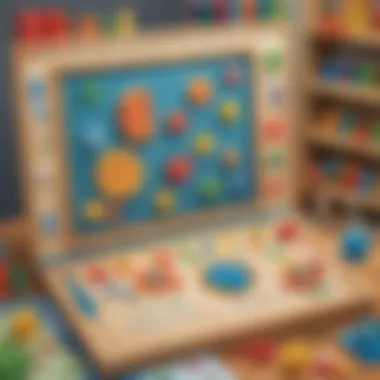Math Engagement in Kindergarten: Strategies for Success


Intro
In an increasingly complex world, embracing mathematical concepts from a young age can provide children with a crucial advantage. Kindergarten serves as the first thread in the vast tapestry of education, where early exposure to numeracy plays a critical role. The aim here is to deepen our understanding of how to engage young minds in mathematics. Such engagement transforms abstract ideas into tangible activities that children can relate to, thus fostering a love for numbers right from the start.
Numerical skills are not just a requirement for future academic success, but they also enhance problem-solving capabilities and critical thinking. Emphasizing fun and interactive strategies enables young learners to build confidence in their abilities. This article will cover various aspects of mathematics engagement in kindergarten, from hands-on creative activities to tools like quizzes that reinforce knowledge. Let’s take a closer look at how we can make mathematics not only a subject to learn but also a thrilling adventure.
Creative Activities
Craft Ideas
Art and mathematics might seem like an unlikely pair at first glance, but they intertwine beautifully in many engaging activities. Think of creating number collages by cutting out pictures of objects that come in groups, such as apples or stars. Children can glue these images onto a piece of construction paper, effectively visualizing quantities. Another idea is making a shape garden where kids can cut out various shapes from colored paper and arrange them to form flowers, helping them explore spatial relationships while developing an eye for geometry.
Step-by-Step Guides
- Number Collage:
- Shape Garden:
- Gather old magazines or print images online.
- Help your child look for items that come in groups (like a trio of bananas).
- Assist them in cutting and gluing these pictures onto the paper, while counting as they go.
- Collect colored paper and scissors.
- Cut out circles, squares, and triangles.
- Let your child create stems and leaves with green paper, arranging the shapes as flowers.
Educational Value
Through these creative tasks, children engage in sight recognition, fine motor skills, and critical thinking. They also begin to understand basic arithmetic and geometry concepts, forming a firm foundation essential for more advanced math later on. The joy from creation builds a positive emotional association with learning, thus transforming math into a lively topic.
Fun Quizzes
Quiz Topics
Using quizzes as a learning tool can spice up mathematical exploration. Topics could range from basic addition and subtraction to recognizing shapes and patterns. Whether on paper or digital platforms like ElemFun, quizzes provide instant feedback, letting kids know how they've done.
Question Types
In engaging quizzes, a mix of question types keeps things interesting:
- Multiple choice questions can help in selecting the correct answer easily.
- Fill in the blanks encourage active recall.
- Image-based questions demonstrate objects to identify and count.
Knowledge Reinforcement
Quizzing serves importantly in reinforcing what children have just learned. When they see the same concepts presented in different ways, it ensures information sticks better. Plus, children gain a sense of achievement, which positively affects their motivation.
Fact-Based Articles
Topics
Filling minds with knowledge also means incorporating facts in an engaging manner. Topics for articles can include those related to number history, how numbers are used in everyday life, or the significance of shapes in nature. This broad spectrum of topics keeps the learning experience varied and interesting.
Engaging Content
Good articles break down complex ideas into bite-sized information that's easy to digest. Including stories or real-life applications of math makes these facts more relatable. Children can connect theoretical knowledge to their own lives, understanding math isn’t just about numbers on a page; it’s everywhere around them.
Preamble to Kindergarten Mathematics
When young children step into the world of kindergarten, they embark on a crucial journey that sets the stage for their future learning. Mathematics is not just a subject; it’s a way of thinking and understanding the world around us. Early mathematical engagement is vital for children as it builds foundational skills that are essential for academic success later on. The skills learned at this stage involve much more than numbers; they encompass problem-solving, reasoning, and the ability to connect concepts.
Early math education allows children to develop both cognitively and socially. By interacting with numbers and shapes, they not only learn to count but also start understanding patterns and relationships, which are key to cognitive growth. The strategies employed in teaching can significantly impact how children perceive and enjoy math. A strong start can lead to lasting confidence and curiosity about the subject, setting the tone for lifelong learning.
"Early mathematics engagement is a unique window that can influence a child’s attitude towards math for years to come."
To summarize, the introduction of math in kindergarten aims to ignite interest and foster skills that will be the building blocks for more complex ideas in the years ahead. This early phase is not just about arithmetic; it's about cultivating a mindset that embraces challenges and perceives learning as an enriching experience. Both cognitive development and emotional well-being are nurtured through engaging and age-appropriate mathematical activities.
The Importance of Early Math Learning
Early math learning serves several critical roles in a child's development. To begin with, it enhances numerical literacy, enabling children to recognize and manipulate numbers confidently. This process fosters a sense of achievement and motivation, pushing them to dive deeper into the subject.
Math skills developed at this stage also pave the way for better performance in more advanced subjects like science and technology, that rely heavily on arithmetical concepts. Skills such as measuring, basic geometry, and recognizing economic patterns are learned early and expand into relevant applications in everyday life.
Some key points regarding the importance of early learning include:
- Building a Positive Attitude: Children who engage in various fun activities feel less intimidated by numbers, laying a positive foundation for future learning.
- Social Skills Enhancement: Collaborative math games develop relationships and communication skills among peers, contributing to both social and cognitive development.
- Problem-Solving Abilities: Engaging with math in a playful manner encourages critical thinking. Children learn to approach problems creatively and develop strategies for overcoming obstacles.
Cognitive Development in Young Children
Cognitive development during early childhood is a fascinating field. Young children absorb knowledge like a sponge, and the right engagements during this phase can lead to significant growth. Mathematics enhances several cognitive functions, including memory, attention span, and reasoning skills.
In particular, engaging with mathematical concepts helps children to:
- Enhance Memory: Numbers and patterns require recall and recognition, which are excellent for strengthening memory capabilities.
- Develop Spatial Reasoning: Activities related to shapes and space help children visualize and manipulate objects, enhancing their understanding of the environment.
- Foster Logical Thinking: Children learn to make connections and explore sequences through math, which promotes logical reasoning.


Thus, addressing cognitive development through math provides a solid framework for not only academic success but also for holistic personal growth. By recognizing the pivotal role that early mathematics plays, educators and parents can craft meaningful experiences that resonate with children, making their learning journey both enjoyable and effective.
Core Mathematical Concepts for Kindergarten
Understanding core mathematical concepts in kindergarten is like laying down the bricks for a sturdy building. These concepts are the foundations upon which future mathematical skills are built. In these early stages, children begin to explore numbers, shapes, patterns, and simple operations. The significance of this exploration cannot be overstated. Engaging with mathematical ideas helps to develop not only numerical skills but also critical thinking and problem-solving abilities. As kids tackle everyday math in playful contexts, they learn to approach challenges with curiosity and creativity.
The goal here is to spark a genuine interest in mathematics, making it a natural part of their world. So how do we engage these little minds? It starts with number recognition, basic arithmetic, and the exploration of patterns and shapes, allowing children to see mathematics in their daily lives.
Number Recognition and Counting
Activities for Number Recognition
Engaging activities for number recognition can spark enthusiasm among kindergarteners. Recognizing numbers is essential as it serves as the first step in building their confidence with numbers. Activities such as number scavenger hunts can be effective, where kids search for items or pictures that represent specific numbers. They can also use flashcards with colorful designs that attract their attention. The visual aspect of these activities plays a significant role as it makes learning fun and interactive.
The key characteristic here is enjoyment. When children are having a blast, they don’t even realize they’re learning! However, one must be mindful that activities need to have age-appropriate complexity. Too much of a challenge might discourage their efforts, while too easy might not engage them enough. Striking a balance here is critical for effective learning.
Games Enhancing Counting Skills
Another engaging way to enhance counting skills is through games. Playing counting games makes learning feel like play. For instance, using board games that require players to count spaces or collect numbered items really makes the counting process lively. Not only do they learn how to count, but they also pick up social skills along the way. It’s a win-win!
The uniqueness of these games lies in their ability to seamlessly blend learning with fun. Kids enjoy the competition, which naturally encourages them to practice counting. It's essential to choose games that align with their current skill levels. Overly complex games can lead to frustration, while simple ones might lead to boredom.
Basic Addition and Subtraction
Hands-On Learning Techniques
Using hands-on techniques in teaching basic addition and subtraction takes the abstract concepts and brings them to life. Activities like using snack items to demonstrate how many apples there are after eating one can turn theory into practice. Kids learn better when they can see, touch, and move objects.
The key here is that kids feel a sense of ownership in their learning process. Real-world connections cement their understanding, making abstract calculations more relatable. It does require some planning and resources, but the payoff in terms of understanding is worth it.
Use of Manipulatives
Manipulatives are tools that allow toddlers to visualize and physically engage with numbers. This could be anything from blocks to counters, or even shapes. The benefit of using manipulatives is that children can physically manipulate objects to see how numbers come together in addition or break apart in subtraction.
A unique feature of manipulatives is that they cater to different learning styles, helping visual and kinesthetic learners grasp basic arithmetic. While they are remarkably effective, one must ensure that the focus remains on the math concepts rather than merely playing with the objects.
Patterns and Sequences
Identifying Patterns in Everyday Life
Identifying patterns in everyday life creates a bridge between mathematics and the natural world. It allows kids to discover sequences and repetitions everywhere they look. For example, while on a nature walk, children can spot patterns in leaves or the way petals are arranged in flowers. This activity enhances their observational skills while making math relatable.
The key characteristic of this approach is its adaptability. Children can apply their knowledge across various contexts. However, care needs to be taken that the tasks do not become repetitive; otherwise, it might lose its appeal.
Creative Pattern-Making Activities
Encouraging children to create their own patterns can be incredibly fulfilling. Using beads or colored paper, kids can craft their unique patterns, which fosters creativity. These activities also aid in fine motor skills while they engage with numbers and shapes.
What sets these creative activities apart is the dual emphasis on art and math learning. It’s beneficial because it not only bolsters their numerical understanding but also taps into their imaginative sides. Maintaining a balance between making it fun and educational is essential, or children might view it merely as another activity rather than a learning experience.
Shapes and Spatial Awareness
Exploring Shapes in the Environment
Exploring shapes in the environment opens children's eyes to the geometry around them. Simple walks or scavenger hunts can involve searching for different shapes, like squares in windows or triangles in rooftops. This visually stimulating approach makes children aware of their surroundings – a fundamental skill in developing spatial awareness.
The key characteristic of this activity is that it encourages observational skills. However, overemphasizing can lead to children feeling pressure to identify every shape, which might take the fun out of learning. Structuring it as a game can keep the excitement alive.
Shape Sorting Games
Using shape sorting games to develop awareness of different shapes and their properties is also essential. These games allow children to categorize shapes based on attributes like color, size, and type, and they serve as an excellent primer for understanding geometry.
The unique edge of shape-sorting games is their tactile nature; children engage in hands-on play, making learning more memorable. However, one must ensure that children don't become frustrated if they don't immediately grasp the concept. Gradual introduction to various shapes can make this process smooth and enjoyable.
Interactive Learning Materials
Interactive learning materials play a critical role in engaging young learners within the realm of mathematics. These tools not only foster understanding but also make the learning experience more enjoyable. When children can manipulate objects physically or interact with digital content, they are more likely to grasp the concepts being taught. Given the natural curiosity of kindergarteners, using engaging materials is essential to their development.
In the digital age, educators and parents have numerous options to choose from, making math accessible and fun. The right interactive tools can spark interest and create foundational numerical skills that contribute to long-term mathematical understanding.
Integrating Math into Daily Activities
Integrating math into daily activities is crucial for cultivating early numerical skills in kindergarten. It transforms abstract concepts into tangible experiences, making learning engaging and practical. Children often learn best through interactive methods, and when math is woven into their routine, it naturally piques their interest. This seamless incorporation demonstrates that math is not about rote memorization; it's a valuable tool for understanding and navigating the world around them.
Math in Cooking and Food
Cooking offers a delightful way to embed math in daily life, as it encompasses various mathematical concepts such as measurement, estimation, and fractions. It provides children with not just the chance to explore numbers but also the opportunity to enjoy a sensory experience that fuels their curiosity and appetite for learning.


Measuring Ingredients Together
Measuring ingredients together is a hands-on activity that illustrates how math plays a role in everyday tasks. It encourages children to use their fractions and counting skills as they scoop flour or pour liquids. Children begin to understand the significance of volume, weight, and the concept of "half" or "quarter" without even realizing they are diving into math!
The beauty of measuring is its direct connection to food. Kids love helping in the kitchen and it’s a way to cement their learning through play. It makes learning stick, as it combines hands-on engagement with appetizing outcomes. However, caregivers should guide this experience positively, ensuring that safety remains paramount when dealing with kitchen tools.
Understanding Fractions through Baking
Baking is another wonderful avenue to explore fractions. When children follow a recipe that requires using one-half cup of sugar, they are naturally engaging with the concept of fractions without formality. Originally a simple task of combining ingredients becomes a rich learning experience, where they can visually see how parts make a whole.
A key characteristic of understanding fractions through baking is how accessible and relatable the concept becomes. It helps demystify fractions by contextualizing them in a fun activity. One disadvantage, though, is not every child might grasp fractions during these exercises, especially if they aren’t ready to connect the dots between ingredient measurements and fraction representation.
Math in Nature and Exploration
Nature offers an endless playground for integrating mathematical concepts naturally into lively explorations. Kids are naturally curious about their environments, and harnessing this curiosity to delve into counting and shape identification can be both fun and educational.
Counting Leaves and Flowers
Counting leaves and flowers is a splendid outdoor activity that keeps youngsters engaged while fostering their counting abilities. Children can collect different leaves and flowers, prompting them to count how many they have collected. This simple action promotes one-to-one correspondence—fundamental for early math skills.
The inclusive nature of this activity allows for various iterations. You could easily shift from counting to sorting by size or color, adding yet another layer of complexity. However, the downside is that this engages only children who directly participate in counting, potentially leaving some observants behind in the learning journey.
Finding Shapes in Nature
Finding shapes in nature is another exciting investigation that develops spatial awareness among young learners. When on a nature walk, children can be encouraged to identify circles, squares, and triangles found in leaves, flowers, and stones. This activity fosters observation and geometric recognition skills in a fun, interactive way.
Inherent to this exercise is its flexibility; nature provides an abundance of shapes and forms waiting to be discovered. A unique feature is the immediate real-world application of the math concepts children encounter. One of its disadvantages, however, is found in varying environments—urban settings might offer fewer opportunities to explore diverse shapes compared to a rural area.
Integrating math into everyday activities not only enhances learning but also builds a lifelong appreciation for mathematics.
These everyday experiences make math relatable, demonstrating its practical applications. Whether through cooking or exploring the outdoors, each activity lays down a piece of the mathematical foundation that children will draw on in years to come.
Assessing Mathematical Understanding
Assessing mathematical understanding in kindergarten plays a crucial role in both the learning journey of children and the teaching strategies that educators employ. Understanding how well a child grasps various mathematical concepts informs instruction, allowing for adjustments based on individual needs. Whether it’s recognizing numbers, grasping basic addition, or understanding shapes, assessing students’ progress ensures that they are equipped with the necessary foundation as they advance in their education.
Employing effective assessment methods not only guides teachers in their lesson planning but also fosters a sense of accomplishment in young learners. Recognizing their own mathematical abilities boosts confidence and encourages persistence through challenges.
Informal Assessment Techniques
Observation and Interaction
Observation and Interaction is a hands-on approach that focuses on watching students as they engage with mathematical tasks. This method allows educators to see how children apply their knowledge in real-time, showcasing their thought processes and problem-solving strategies. One key characteristic of this technique is its unobtrusiveness; it doesn’t impose stress as traditional assessments might. Instead, it feels more like a natural part of the learning environment.
A major benefit of Observation and Interaction is that it gives immediate feedback. For example, if a child struggles with counting during an activity, a teacher can step in, guide them, and adjust their approach accordingly. However, while rewarding, this method may also provide challenges. Without careful documentation, valuable insights can be lost, making it crucial for teachers to keep notes or checklists to track progress over time.
Play-Based Assessments
Play-Based Assessments leverage the natural inclination of children to play as a tool for learning. By embedding mathematical understanding within games and playful activities, educators can gauge a child’s skills in an enjoyable context. The charm of Play-Based Assessments lies in their ability to blend assessment with active learning, promoting engagement.
This method is particularly beneficial because it reduces anxiety around testing. When children see their assessments as play, they are more likely to express themselves freely. A unique feature of this form of assessment is that it fosters creativity and exploration. Nevertheless, these assessments can sometimes lack structure, potentially leading to misinterpretation of a child's abilities if not conducted with clear objectives in mind.
Formal Assessment Tools
Standardized Testing at a Young Age
Standardized Testing at a Young Age often comes with mixed feelings among parents and educators. While the structured nature of these assessments provides quantifiable data on a child’s mathematical abilities, there are concerns about their appropriateness for young learners. The idea behind such testing is to evaluate a child’s grasp of basic concepts, offering a broad snapshot of their skills.
A notable advantage is that it allows for a comparative analysis among peers, which can be beneficial in identifying areas needing attention. Yet, critics argue that these tests can create pressure and anxiety for young children, possibly hindering their natural love for learning. It’s essential that standardized tests are carefully designed to suit developmental stages and learning diversity.
Alternative Assessment Strategies
Alternative Assessment Strategies encompass various approaches aimed at evaluating student understanding without relying solely on traditional methods. This may include portfolios, self-assessments, or collaborative projects that showcase a child's growth over time. One of the key strengths of these strategies is that they offer a more holistic view of a child’s skills and understanding beyond mere numerical scores.
They are often more adaptable to individual learning styles and offer children a chance to express their knowledge in varied forms. However, the unique feature that might hinder their effectiveness is the time required for teachers to design and implement these assessments. Additionally, analyzing and interpreting diverse forms of assessment can be more complex than traditional testing methods.
Engaging Parents and Caregivers
In the realm of early childhood education, the role of parents and caregivers is absolutely pivotal. Engaging them in the mathematical journey of their children cultivates a solid foundation and fortifies the relationship between home and school learning. When parents are actively involved, children tend to display greater enthusiasm and commitment towards their mathematical skills. They also feel supported and encouraged to explore numbers and patterns, which is essential at this formative stage.
Strategies for Parental Involvement
Creating a Math-Friendly Home Environment
Establishing a math-friendly home can make a world of difference in how children perceive and engage with mathematics. A math-friendly space is not just about having a few toys or books – it’s about embedding numerical concepts into daily life. This can be as simple as having counting games available during playtime or incorporating math discussions during routine activities.
The key characteristic of a math-friendly home is accessibility. By ensuring that mathematical tools, like blocks, counting beads, or measuring cups, are within easy reach, parents create an environment ripe for exploration. One unique feature of such an environment is that it encourages spontaneous learning. However, one must keep in mind that it’s also essential to balance play with guidance. Too much structure can dampen creativity, while too little can lead to confusion.


Setting Consistent Learning Routines
Setting consistent learning routines can dramatically enhance a child’s ability to grasp mathematical concepts. A reliable schedule integrates math into daily activities, making it less of a chore and more of an integrated part of their lives. The having of routine reinforces the norm that, "Math isn't just at school; it’s in our daily world."
A vital aspect of this is the predictability of the routine. Children thrive on knowing what to expect, and having a designated math time can ease anxiety related to learning. A unique quality of this approach is its adaptability. Parents can weave these routines into existing activities like bedtime stories or during meals. While establishing such routines can be challenging initially, the long-term benefits often outweigh the initial effort, aiding children in developing a confident and positive attitude towards math.
Resources for Parents
Books and Online Resources
Books and online resources serve as both valuable tools and enhancers of learning. They provide engaging narratives that can introduce complex mathematical concepts through fun and relatable stories. This kinship between learning and enjoyment is crucial for young kids.
A major characteristic of good educational materials is how they cater to diverse learning styles. From colorful illustrations in picture books to interactive math games available online, there’s plenty to choose from. These resources also often encourage parental participation, which can strengthen bonds while facilitating learning. One downside, however, is that the sheer volume of available materials can be overwhelming, making it vital for parents to do a bit of research to find what best suits their child's needs.
Workshops and Community Programs
Workshops and community programs offer an arena for parents to learn together with their children. These programs provide hands-on experiences, often incorporating unique math games and activities that are both fun and educational. This shared experience not only reinforces learning but also builds a community that fosters support and exchange of ideas among families.
The most significant feature here is the community engagement aspect. Parents get to meet others who are also navigating the complexities of introducing mathematics to their children. However, one might note that access to such programs can vary widely based on location, which could limit participation for some families. It’s crucial to seek out options that best align with one's schedule and geographical considerations to reap the full benefits of these initiatives.
Engaging parents in their children's math education is not just about reinforcing skills but building a collaborative community that supports lifelong learning.
Challenges in Teaching Kindergarten Math
The journey of teaching math to kindergarten children comes with its own set of hurdles. Each child steps into the classroom with a unique background, a distinct learning style, and various levels of readiness. This variability can create a complex atmosphere for educators trying to provide the best mathematical foundation. Addressing these challenges is essential, as they can significantly shape young learners’ attitudes and skills in math, potentially affecting their future academic paths.
Addressing Diverse Learning Needs
Tailoring Instruction for Different Skill Levels
To effectively engage students, educators must recognize that not all children learn at the same pace. Tailoring instruction to meet varying skill levels is not just a strategy; it’s a necessary approach in today’s diverse classrooms. When teachers adapt their lessons to align with each child's understanding, they create an inclusive environment where everyone can thrive.
One key characteristic of this practice is differentiation. By employing this, educators can modify content, processes, and products to match the learner's abilities. This approach is beneficial for ensuring no child is left behind as they work through fundamental concepts in arithmetic or shape recognition.
A unique benefit of tailoring instruction includes the ability to offer more complex tasks to advanced learners while providing foundational support for those struggling. However, this can also lead to increased demands on teachers, requiring careful planning and implementation.
Incorporating Special Needs Strategies
Special needs strategies are critical in making sure that all children, regardless of their challenges, have access to math education tailored to their needs. This segment addresses the instructional adjustments necessary for accommodating children on the spectrum of learning abilities.
The principle of universal design for learning often comes into play here. This framework emphasizes presentation, engagement, and expression, enabling all students to participate meaningfully in mathematical exploration. It is a popular choice because it provides flexibility and encourages creativity in learning strategies that benefit all, not just those with identified needs.
The incorporation of specialized instructional tools and resources can greatly assist in this effort. For example, visual aids might work wonders for some children, while others might need manipulative tools or tactile experiences. The downside? Developing these strategies requires significant training and ongoing support for educators, emphasizing the importance of professional development in the educational framework.
Overcoming Math Anxiety
Building Confidence through Success
Building confidence is key in nurturing a child's relationship with math. Success in small tasks can make a world of difference, encouraging kids to take on more challenging concepts without fear.
The central feature of this approach is the gradual increase in challenge. By starting with simple tasks and gradually introducing more complex ones, children can enjoy a sense of accomplishment, fueling their motivation to learn further. This consistent positive feedback loop creates a nurturing environment where students feel valued and capable, a crucial aspect of effective early math education.
However, relying solely on building confidence through success can have its drawbacks. If not scaffolded correctly, some children may plateau in their learning, suggesting the need for a balance between easy wins and meaningful challenges.
Promoting a Positive Attitude toward Math
A positive mindset towards mathematics is vital for long-term success. Instilling a “can-do” attitude in children helps them view math as an enjoyable challenge rather than a daunting task.
Focusing on growth mindset principles—embracing mistakes as learning opportunities—allows children to see value in persistence. As they encounter challenges, the reassurance that effort leads to improvement can be empowering and transformative.
Unique features of this approach might include storytelling or relatable narratives that frame mathematical concepts in a fun, less intimidating light. However, overemphasis on positivity without addressing struggles can lead to unrealistic expectations for children, stressing the importance of honest engagement with their learning process.
Effective teaching of kindergarten math requires recognizing and responding to the diverse range of learners in the classroom. With the right strategies and support, overcoming these challenges is not only possible but can lead to a joyful math experience.
In tackling the hurdles in teaching math to youngsters, educators play a pivotal role. Their strategies not only impart essential numeracy skills but also lay the groundwork for fostering a lifetime of positive engagement with mathematics.
End and Future Directions
The journey through early mathematics in kindergarten is more than just teaching numbers; it's laying down the bricks for lifelong learning. As we wrap up this exploration, it's crucial to recognize that the strategies and discussions we’ve had serve as a stepping stone for children's educational paths. Every activity, whether it’s counting fingers or measuring flour during baking, plants a seed that grows over time, blossoming into essential skills down the road.
Long-Term Benefits of Early Math Skills
Fostering mathematical understanding in early childhood pays off in several ways. First off, children who grasp foundational math concepts tend to excel in higher grades. Research indicates that the skills they develop during these formative years can lead to improved problem-solving abilities and logical reasoning. Here are some key points:
- Enhanced Cognitive Skills: Early exposure leads to stronger brain development, particularly in areas involving spatial awareness and critical thinking.
- Academic Achievement: Kids with a solid math background often score higher in standardized tests. It’s like having a head start in a race.
- Increased Confidence: Children who feel capable in math are more likely to tackle challenges in other subjects, fostering a more positive attitude toward learning overall.
Encouraging kids to explore math naturally allows them to build a sense of wonder and discovery. They begin to see numbers as tools for understanding the world rather than mere symbols on a page.
Emerging Trends in Early Math Education
Education is ever-evolving, and math teaching is no exception. As our understanding of child development deepens, so do our approaches. Here are a few noteworthy trends shaping early math education today:
- Emphasis on Play-Based Learning: This method is gaining traction. It’s all about making math fun, which increases engagement. Kids learn best when they don’t feel like they’re in a classroom. Think of activities that blend play and math – like using toys for counting.
- Technology-Integrated Learning: Interactive apps and games are becoming must-haves in the math toolkit for kindergarten. Sites like Britannica and Reddit provide platforms for sharing educational resources tailored to young learners.
- Inclusive Teaching Practices: Recognizing the diverse needs of all students is crucial. Strategies that accommodate various learning styles—visual, auditory, kinesthetic—ensure that every child can thrive. Teachers today are trained not just to teach but to connect with each child’s unique learning journey.
In summation, as we look towards the future, it’s vital to adapt and expand our methods continually. With the right resources and a supportive environment, we can nurture the next generation to become not just competent in math, but excited by it. Every bit of encouragement and every engaging experience counts, building a future where children see math not as a subject to endure, but as a valuable tool for navigating life.







